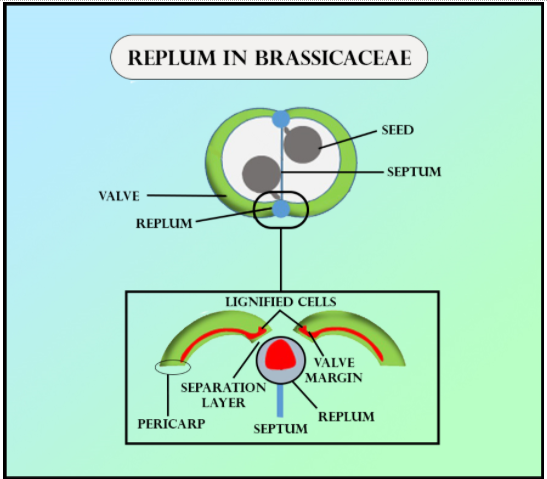
Replum is characteristic of family
(a)Brassicaceae
(b)Asteraceae
(c)Liliaceae
(d)Solanaceae
Answer
577.2k+ views
Hint: Replum is seen as a thin false septum, present in some fruits such as siliques and some legumes. Replum acts as a divide and separates two valves or chambers of the fruits. Replum is found in the mustard family or also called as crucifers.
Complete answer:
Their gynoecium is of dicarpellary and syncarpous type, with ovary superior, unilocular, which becomes bilocular due to the development of the false septum called replum.
This septum is actually an extension of its placenta. They show parietal placentation, with many ovules. They have a short style and the stigma may be simple or bifid.
Thus, replum is a characteristic feature of the family Brassicaceae or Cruciferae.
Additional Information:
The Brassicaceae is the 4th largest family, with 169 species and varieties of plants. The family is very important from the economic point of view, which includes mustard, cabbage, cauliflower, turnips, radish, etc.
Plants belonging to the Brassicaceae family are mostly annual, biennial, or perennial herbaceous plants, others are dwarf shrubs and very few are vines.
Flowers may be arranged in a racemose pattern or as panicles, or corymbs too.
The flowers are bisexual having a star symmetry and the ovary positioned superiorly. Flowers have four free or sometimes merged sepals, the lateral two sometimes having a shallow spur, which is shed after flowering. Each flower has four petals, alternating with the sepals, although they may be absent or rudimentary in some species.
It initially is formed of only one cavity but during development, a thin wall grows dividing the cavity, both placentas and thus separates the two chambers. Rarely, a single cavity without a replum may be seen, but in most cases, a replum is seen.

So, the answer is, “Brassicaceae.”
Note: Replum or the false septum is a characteristic feature of this family. However, septa are seen in the ovules of many plants. In those plants, the ovary is said to be bilocular or multilocular depending on the number of septa. Example, Family Solanaceae.
Complete answer:
Their gynoecium is of dicarpellary and syncarpous type, with ovary superior, unilocular, which becomes bilocular due to the development of the false septum called replum.
This septum is actually an extension of its placenta. They show parietal placentation, with many ovules. They have a short style and the stigma may be simple or bifid.
Thus, replum is a characteristic feature of the family Brassicaceae or Cruciferae.
Additional Information:
The Brassicaceae is the 4th largest family, with 169 species and varieties of plants. The family is very important from the economic point of view, which includes mustard, cabbage, cauliflower, turnips, radish, etc.
Plants belonging to the Brassicaceae family are mostly annual, biennial, or perennial herbaceous plants, others are dwarf shrubs and very few are vines.
Flowers may be arranged in a racemose pattern or as panicles, or corymbs too.
The flowers are bisexual having a star symmetry and the ovary positioned superiorly. Flowers have four free or sometimes merged sepals, the lateral two sometimes having a shallow spur, which is shed after flowering. Each flower has four petals, alternating with the sepals, although they may be absent or rudimentary in some species.
It initially is formed of only one cavity but during development, a thin wall grows dividing the cavity, both placentas and thus separates the two chambers. Rarely, a single cavity without a replum may be seen, but in most cases, a replum is seen.

So, the answer is, “Brassicaceae.”
Note: Replum or the false septum is a characteristic feature of this family. However, septa are seen in the ovules of many plants. In those plants, the ovary is said to be bilocular or multilocular depending on the number of septa. Example, Family Solanaceae.
Recently Updated Pages
Master Class 12 Business Studies: Engaging Questions & Answers for Success

Master Class 12 Economics: Engaging Questions & Answers for Success

Master Class 12 English: Engaging Questions & Answers for Success

Master Class 12 Maths: Engaging Questions & Answers for Success

Master Class 12 Social Science: Engaging Questions & Answers for Success

Master Class 12 Chemistry: Engaging Questions & Answers for Success

Trending doubts
What is meant by exothermic and endothermic reactions class 11 chemistry CBSE

Which animal has three hearts class 11 biology CBSE

10 examples of friction in our daily life

One Metric ton is equal to kg A 10000 B 1000 C 100 class 11 physics CBSE

1 Quintal is equal to a 110 kg b 10 kg c 100kg d 1000 class 11 physics CBSE

Difference Between Prokaryotic Cells and Eukaryotic Cells




